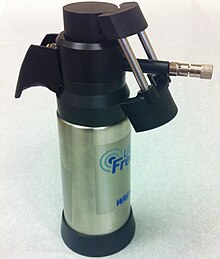Informatics Educational Institutions & Programs
Contents

Freeze spray (cold spray or vapocoolant) is a type of aerosol spray product containing a liquified gas used for rapidly cooling surfaces, in medical and industrial applications. It is usually sold in hand-held spray cans. It may consist of various substances, which produce different temperatures, depending on the application.
Some of them are highly flammable.[1] Several other types of compressed gas sprays also have a freezing effect: for example, tetrafluoroethane, gas dusters, liquid nitrogen, and carbon dioxide fire extinguishers.
Applications

Industrial
For spot-cooling of electronic components during troubleshooting, dimethyl ether or tetrafluoroethane may be used.[2]
Freeze sprays are also used to contract metal for assembly or disassembly of interference fit parts.[citation needed]
The extreme temperature can cause viscoelastic materials to change to glass phase. Thus it is useful for removing many types of pressure sensitive adhesives.[3]
Medical

In medical applications, spray cans containing dimethyl ether[4] or tetrafluoroethane may also be used to freeze and destroy tissue, for removal of warts and skin tags, or other uses in cryosurgery. Liquified petroleum gas including propane and butane is sometimes used. These all may also be used as a topical anesthetic, due to the numbing effect of cold, though there is risk of frostbite.
Chloroethane may be used as a topical pain reliever, and an alternative to ice pack therapy to reduce inflammation and swelling. Since its boiling point is well above the freezing point of water, there is less risk of freezing the skin, though it can still be dangerous if misused. It may be used to treat sports injuries, where it is sometimes known as ice spray or magic spray.[5]
Other
Freeze spray has been shown useful for the field marking of animals; for example marking the tails of monkeys. Research is continuing to help control the application dosage and time to minimize permanent damage to the animals.[6]
See also
References
- ^ Shadgan B, Med S, Pakravan AH, Hoens A, Reid WD. Subcutaneous and Intramuscular Hemodynamics and Oxygenation After Cold-Spray Application as Monitored by Near-Infrared Spectroscopy. J Athl Train. 2015;50(8):800-805. doi:10.4085/1062-6050-50.6.02
- ^ Knight KL, Brucker JB, Stoneman PD, Rubley MD. Muscle injury management with cryotherapy. Athl Ther Today. 2000;5(4):26–30.
- ^ US 5798169, Smith, Christopher A., "Self-containing tamper evident seal", published 1998-08-25, assigned to Sealed Air Corp.
- ^ "A Pharmacist's Guide to OTC Therapy: OTC Treatments for Warts". July 2006. Archived from the original on 2010-06-17. Retrieved 2017-08-26.
- ^ Widman, Miriam (June 16, 2015). "'Magic' freeze sprays can do deep damage". Deutsche Welle. Retrieved August 26, 2017.
- ^ Fernandez-Duque1, Eduardo (2003), "Field Methods for Capturing and Marking Azarai Night Monkeys" (PDF), International Journal of Primatology, 24 (5): 1113–1120, doi:10.1023/a:1026284430453, S2CID 44002464, retrieved 28 August 2017
{{citation}}: CS1 maint: numeric names: authors list (link)

















